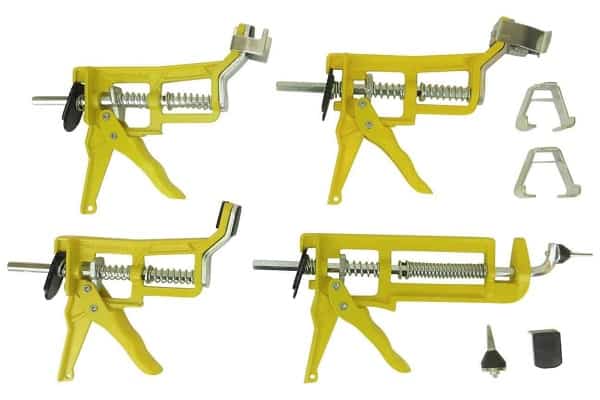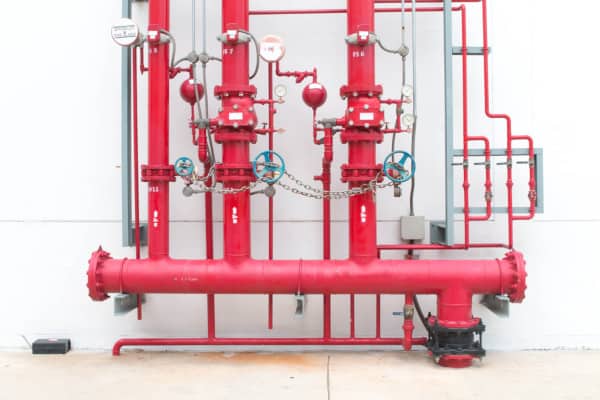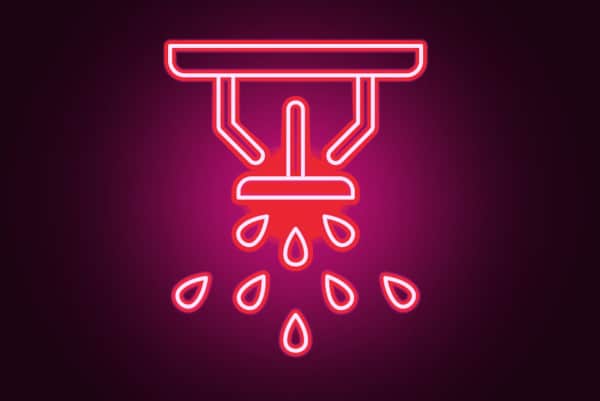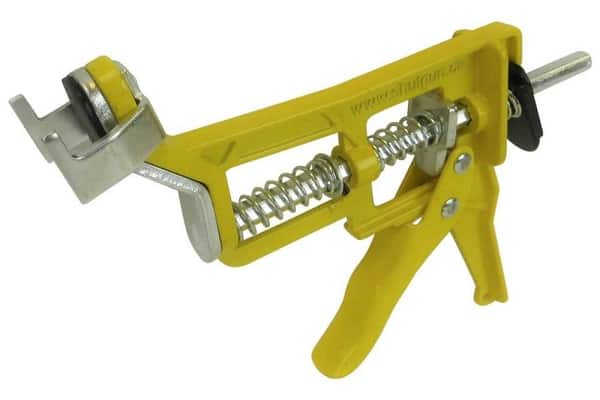Shutgun tools turn off activated fire sprinklers fast—and without impairing the system
Whether it’s because of flying objects, coat hangers, careless construction workers, errant forklifts, or vandalism, fire sprinklers sometimes activate when there’s no fire. According to the National Fire Protection Association (NFPA), fire departments responded to about 33,600 accidental fire sprinkler activations in 2014. Depending on the type, fire sprinklers can put out between 15 and 40 gallons of water per minute, and these incidents can cause significant property damage.
When fire sprinklers activate unintentionally (or when they work as intended), you basically have two options to stop the water: turn off a control valve or use fire sprinkler tools—a sprinkler stopper like the Shutgun—to stop the flow at an activated sprinkler.
In this article, we look at both options, explaining:
- The basic challenges of control valves and the benefits of sprinkler stoppers
- Why model standards often make it hard to turn off the control valve
- The consequences of turning off the control valve
- How a Shutgun stops water quickly, locally, and keeps the fire sprinkler system working
Need a sprinkler stopper now? Browse our full selection of Shutgun fire sprinkler shutoff tools.
The challenges of operating control valves and the benefits of Shutgun sprinkler stoppers
Closing a sprinkler control valve or the specific valve governing the water main involves a few obstacles. First, these valves might not be easily accessible—for a good reason.
Closed control valves are the most common cause of perfectly functional fire sprinkler systems failing to activate during a fire. Therefore, model standards and fire codes encourage sprinkler valves to be locked open, and, by design, most people don’t have the key.
Even if someone accesses and closes the valve quickly, water keeps flowing until the pipe is empty, causing additional damage. Finally, turning off the water to stop an activated sprinkler may be overkill. Yes, you’ve stopped the water. But you’ve also rendered all of the downstream sprinklers useless in the event of a real fire.
Shutgun lets you quickly stop the flow of water from an individual fire sprinkler, without causing a potential system-wide impairment. There’s no need to hunt for a control valve. Simply insert the tool into the sprinkler head frame and squeeze the trigger a few times to seal the hole.
Even better, these tools act as temporary fire sprinklers and restore the broken sprinkler to operational status until it is replaced. A built-in, temperature-sensitive fusible link will disengage the seal in the event of a fire, causing water to flow again.

The control valve will stop the water—if you can get to it
When your toilet overflows, you close the valve to stop the water. When a fire sprinkler activates accidentally, a similar principle works—find the control valve and turn it off. Unfortunately, that may be easier said than done with commercial fire sprinkler systems.
Employees don’t know where and what control valves and riser rooms are
Most people don’t know how fire sprinkler systems work. Some of this comes from misinformation—how often do movies show all the fire sprinklers activating at once? But really, few people spend much time thinking about fire sprinklers—though many of our wonderful readers are the exception.
If your plan to stop an accidentally activated fire sprinkler is to turn off a control valve, you need well-trained staff with access to control valves. The building manager and a few maintenance workers might know where this equipment is, but they probably aren’t always around. A facility’s warehouse stockers, a hotel’s workers, or other personnel in other settings probably don’t know how to operate (and potentially unlock) the water shutoff valve, much less where it is.

Model fire standards encourage locked control valves
Whether it’s done by well-intentioned staff or malicious actors, shutting off a control valve turns a sprinklered building into an unprotected building. For this reason, the National Fire Protection Association (NFPA) encourages valves to be locked, supervised, or sealed.
NFPA 25: Standard for the Inspection, Testing, and Maintenance of Water-Based Fire Protection Systems requires all control valves to be inspected weekly (13.3.2.1) to ensure that they are in the correct position, accessible, not leaking, and properly labeled, among other things. This can be an onerous requirement, so the NFPA offers exceptions if control valves are protected:
From the 2020 edition of NFPA 25
13.3.2.1.1 Valves secured with locks or supervised in accordance with applicable NFPA standards shall be permitted to be inspected monthly.
13.3.2.1.2 Valves that are electrically supervised shall be permitted to be inspected quarterly.
NFPA 13: Standard for the Installation of Sprinkler Systems explains that “A padlock, with a chain where necessary, is especially desirable to prevent unauthorized closing of control valves …” And it specifies that keys should be held “only by those directly responsible for the fire protection system” and that valves should be locked individually (A.16.9.3.3).
Seals and supervisory devices don’t prevent anyone from closing a valve. Instead, they create a physical or an electronic record of the event, respectively, and, in the latter case, a notification. Tamper switches are supervisory devices that send a signal to the control panel when someone closes the valve. These fulfill the “electrically supervised” requirement that enables control valves to be inspected quarterly instead of weekly.
These NFPA standards, however, mean that there is a good chance that the control valve is locked open. If the keyholder can quickly operate the valve during an accidental fire sprinkler activation, great. If that person isn’t readily available, water keeps flowing until they are located.
Water flows until the pipes are empty
Finally, bear in mind that turning off the control valve doesn’t instantly stop water from flowing. There will still be water in the pipes—perhaps quite a lot, depending on the location of the sprinkler and the size of the system. While it won’t be under as much pressure, the water will keep coming until the pipes are empty after the control valve is turned off.
When you turn off a control valve, you create a system impairment
As defined by NFPA 25 (3.3.21), an impairment happens when all or part of a fire protection system is out of order, “and the condition can result in the fire protection system or unit not functioning in a fire event.” When you turn off a control valve, you create an impairment. By shutting off the water supply, every fire sprinkler downstream of the valve is rendered useless.
Of studied fire sprinklers that failed to operate during a fire event between 2010-2014, 59% didn’t work because the system was shut off, according to NFPA research.
Obviously, closing a control valve is better than letting the water run—but understand that doing so has practical consequences. If any impairment puts a fire protection system out of service for more than 10 hours in a 24-hour period, NFPA 25 requires one of the following measures:
- Evacuation of the building or the affected portion of the building
- Establishment of a fire watch
- Elimination of fuel sources and ignition sources
- Establishment of a temporary water supply, if applicable (this doesn’t apply to an accidental sprinkler activation)
Any of these steps will be costly. Note that a single inactive sprinkler may not constitute an impairment, depending on the system’s size. But no water supply to the system or a portion of the system will. The water needs to be turned back on soon.
Read more about fire protection deficiencies and impairments.
Shutgun turns off sprinkler heads fast without losing sprinkler coverage or creating an impairment
As we’ve explained, turning off control valves takes time and can leave your fire sprinkler system impaired. But the Shutgun fire sprinkler tool lets you stop the water in seconds and keeps the fire sprinkler system operational.
Shutgun stops the water quickly
Shutgun sidesteps the need to close valves by sealing the fire sprinkler outlet. These sprinkler stoppers are essentially a spring-loaded “gun” (similar to a caulk gun) that operates a jaw system, sealing the outlet with a rubber element. Check out this video to see a concealed model in action:
Ideally, a Shutgun should be placed on each floor of a building near the fire extinguisher, making these sprinkler tools easy to find and access. Not every employee will have the key to a fire sprinkler control valve, but they can all find and use the Shutgun, with brief training.
Shutguns leave the whole sprinkler system—even the broken head—operational
Besides stopping water quickly, Shutguns also save you the risk of a non-working sprinkler and a potentially impaired fire sprinkler system. Instead of closing the control valve and turning off the water for all of the downstream sprinklers, it plugs the broken sprinkler. The rest of the sprinklers will work as intended. Of course, you’ll have to turn off the control valve when a qualified individual arrives to replace the broken sprinkler head. But if it’s just one head that needs replacement, impairment procedures probably won’t be needed.
Better still, Shutgun works as a temporary fire sprinkler. These sprinkler tools feature a fusible link—similar to the triggers found in some fire sprinkler heads—that melts when exposed to high temperatures. An “ordinary” red fire sprinkler bulb has a temperature rating of between 135 and 170° F. Shutgun’s fusible link melts at 165° F, causing the springs to disengage the jaw and allow the whole assembly to fall away. Water then flows as normal.
See how the Shutgun activates toward the end of this short video:
Shutgun saves you from water damage, the life safety risk posed by an inactive system, and potential impairment costs
Automatic fire sprinkler systems save lives. They’re reliable pieces of equipment that rarely activate unintentionally. Unfortunately, human error knows no bounds, and sometimes sprinkler heads break. Whether it’s a bowling ball, a wedding dress hung on a sprinkler, a stray forklift, or vandalism, these things happen.
Without a tool like Shutgun, your choices are to turn off a specific fire sprinkler control valve or the water main. Depending on the circumstances, both of these choices can take a lot of time. They also disable every fire sprinkler head downstream of the valve. And if this valve stays closed for a long time, you have a serious (and expensive) problem.
The Shutgun sprinkler tools save properties from more extensive water damage by plugging up fire sprinklers fast while keeping the water running and temporarily replacing the broken sprinkler.
To protect your building, shop our selection of Shutgun tools and accessories.
The standard Shutgun works in most cases—when a sprinkler head is not a concealed or institutional model, and it has not been sheared off:
The Sheared Head Shutgun does the job when the whole deflector plate and assembly have been broken off:
The Concealed Head Shutgun lets you reach concealed and deeply recessed sprinkler heads:
Finally, the Institutional Shutgun works with institutional sprinkler heads that are often used in settings where tampering is likely, such as prisons and psychological hospitals:
For an all-in-one solution, consider the Complete Shutgun Kit, which features all four Shutgun models, plus accessories and spare parts. You can also shop for replacement parts, including springs, rubber pads, probes for the concealed head Shutgun, and extension pieces that let Shutgun tools work with 3/4″ NPT sprinkler heads.
If you have questions or need help placing an order, call us at +1 (888) 361-6662 or email support@qrfs.com.
This blog was originally posted at blog.qrfs.com. If this article helped you, check us out at Facebook.com/QuickResponseFireSupply or on Twitter @QuickResponseFS.







Our USAG-Humphreys fire department in south Korea,
has over 800 buildings; like barracks, publics, family tower and large multi purpose building, schools, shopping malls etc..
there are many different type of sprinkler head has been install many different building currently.
then, I wants quote for ; 10the Complete Shutgun Kit( For an all-in-one solution, consider the Complete Shutgun Kit,)
Thank you for reaching out. We will have someone from our QRFS Customer Support Team contact you, and you can also email any requests there to get faster service!